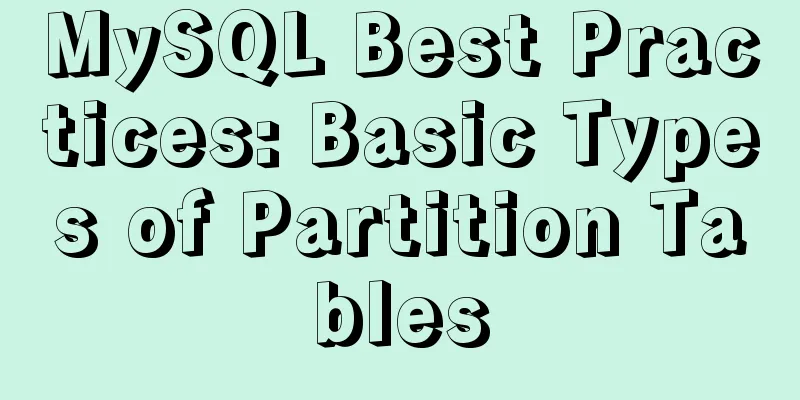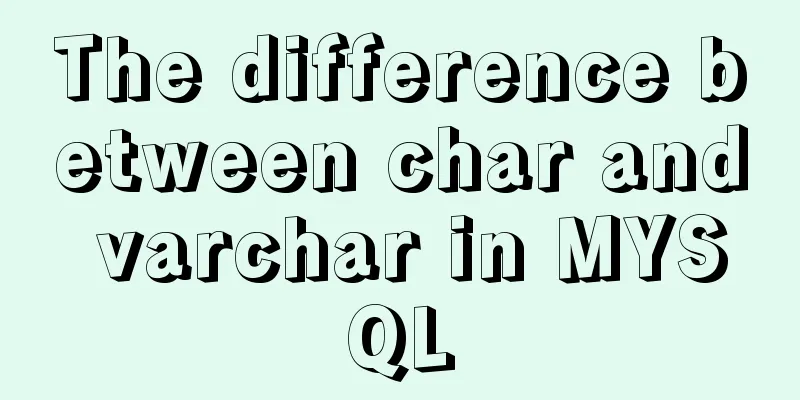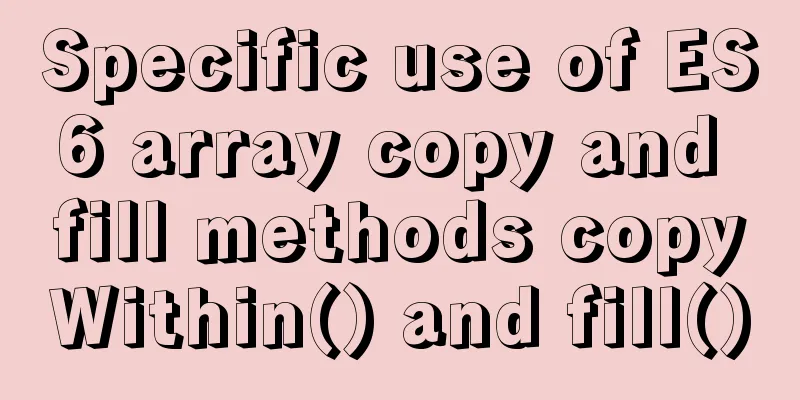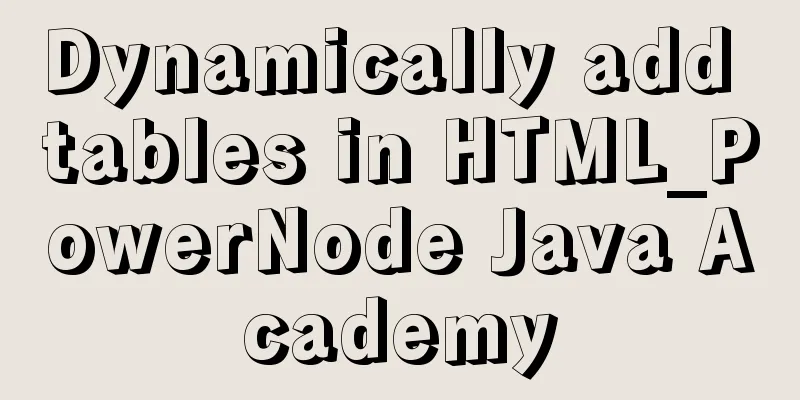MySQL Best Practices: Basic Types of Partition Tables

|
Overview of MySQL Partitioned Tables As MySQL becomes more and more popular, the data stored in MySQL is getting larger and larger. In our daily work, we often encounter a table that stores hundreds of millions or even billions of records. These tables store a large amount of historical records. Cleaning up these historical data is a headache because all the data is in a common table. Therefore, you can only enable one or more delete statements with where conditions to delete (usually the where condition is time). This puts a lot of pressure on the database. Even though we removed these, the underlying data files did not get any smaller. Facing this kind of problem, the most effective way is to use the partition table. The most common partitioning method is to partition by time. One of the biggest advantages of partitioning is that it can clean up historical data very efficiently. Partition Type Currently, MySQL supports four types of partitioning: range partitioning (RANGE), list partitioning (LIST), hash partitioning (HASH), and KEY partitioning. Let's take a look at each partition type: RANGE partitioning Assigns multiple rows to partitions based on column values that fall within a given contiguous interval. The most common one is based on the time field. The partition-based column is preferably an integer. If it is a date type, a function can be used to convert it to an integer. In this example, the to_days function is used
CREATE TABLE my_range_datetime(
id INT,
hiredate DATETIME
)
PARTITION BY RANGE (TO_DAYS(hiredate) ) (
PARTITION p1 VALUES LESS THAN ( TO_DAYS('20171202') ),
PARTITION p2 VALUES LESS THAN ( TO_DAYS('20171203') ),
PARTITION p3 VALUES LESS THAN ( TO_DAYS('20171204') ),
PARTITION p4 VALUES LESS THAN ( TO_DAYS('20171205') ),
PARTITION p5 VALUES LESS THAN ( TO_DAYS('20171206') ),
PARTITION p6 VALUES LESS THAN ( TO_DAYS('20171207') ),
PARTITION p7 VALUES LESS THAN ( TO_DAYS('20171208') ),
PARTITION p8 VALUES LESS THAN ( TO_DAYS('20171209') ),
PARTITION p9 VALUES LESS THAN ( TO_DAYS('20171210') ),
PARTITION p10 VALUES LESS THAN ( TO_DAYS('20171211') ),
PARTITION p11 VALUES LESS THAN (MAXVALUE)
);p11 is a default partition, and all records greater than 20171211 will be in this partition. MAXVALUE is an infinite value. p11 is an optional partition. If this partition is not specified when defining the table, we will receive an error when inserting data greater than 20171211. When we execute a query, we must include the partition field. This allows you to use the partition trimming feature mysql> insert into my_range_datetime select * from test; Query OK, 1000000 rows affected (8.15 sec) Records: 1000000 Duplicates: 0 Warnings: 0 mysql> explain partitions select * from my_range_datetime where hiredate >= '20171207124503' and hiredate<='20171210111230'; +----+-------------+-------------------+--------------+------+---------------+------+---------+------+--------+-------------+ | id | select_type | table | partitions | type | possible_keys | key | key_len | ref | rows | Extra | +----+-------------+-------------------+--------------+------+---------------+------+---------+------+--------+-------------+ | 1 | SIMPLE | my_range_datetime | p7,p8,p9,p10 | ALL | NULL | NULL | NULL | NULL | 400061 | Using where | +----+-------------+-------------------+--------------+------+---------------+------+---------+------+--------+-------------+ 1 row in set (0.03 sec) Note the content of partitions in the execution plan. Only three partitions, p7, p8, p9, and p10, are queried. From this, it can be seen that partition pruning can indeed be achieved using the to_days function. The above is based on datetime. If it is timestamp type, what if we encounter the above problem? In fact, MySQL provides a RANGE partitioning scheme based on the UNIX_TIMESTAMP function. In addition, only the UNIX_TIMESTAMP function can be used. If other functions, such as to_days, are used, the following error will be reported: "ERROR 1486 (HY000): Constant, random or timezone-dependent expressions in (sub)partitioning function are not allowed". And the official documentation also mentions "Any other expressions involving TIMESTAMP values are not permitted. (See Bug #42849.)". Next, we will test the RANGE partitioning scheme based on the UNIX_TIMESTAMP function to see if it can achieve partition pruning. Partitioning scheme for TIMESTAMP The table creation statement is as follows:
CREATE TABLE my_range_timestamp (
id INT,
hiredate TIMESTAMP
)
PARTITION BY RANGE ( UNIX_TIMESTAMP ( hiredate ) ) (
PARTITION p1 VALUES LESS THAN ( UNIX_TIMESTAMP('2017-12-02 00:00:00') ),
PARTITION p2 VALUES LESS THAN ( UNIX_TIMESTAMP('2017-12-03 00:00:00') ),
PARTITION p3 VALUES LESS THAN ( UNIX_TIMESTAMP('2017-12-04 00:00:00') ),
PARTITION p4 VALUES LESS THAN ( UNIX_TIMESTAMP('2017-12-05 00:00:00') ),
PARTITION p5 VALUES LESS THAN ( UNIX_TIMESTAMP('2017-12-06 00:00:00') ),
PARTITION p6 VALUES LESS THAN ( UNIX_TIMESTAMP('2017-12-07 00:00:00') ),
PARTITION p7 VALUES LESS THAN ( UNIX_TIMESTAMP('2017-12-08 00:00:00') ),
PARTITION p8 VALUES LESS THAN ( UNIX_TIMESTAMP('2017-12-09 00:00:00') ),
PARTITION p9 VALUES LESS THAN ( UNIX_TIMESTAMP('2017-12-10 00:00:00') ),
PARTITION p10 VALUES LESS THAN (UNIX_TIMESTAMP('2017-12-11 00:00:00') )
);Insert data and view the execution plan of the above query mysql> insert into my_range_timestamp select * from test; Query OK, 1000000 rows affected (13.25 sec) Records: 1000000 Duplicates: 0 Warnings: 0 mysql> explain partitions select * from my_range_timestamp where hiredate >= '20171207124503' and hiredate<='20171210111230'; +----+-------------+-------------------+--------------+------+---------------+------+---------+------+--------+-------------+ | id | select_type | table | partitions | type | possible_keys | key | key_len | ref | rows | Extra | +----+-------------+-------------------+--------------+------+---------------+------+---------+------+--------+-------------+ | 1 | SIMPLE | my_range_timestamp | p7,p8,p9,p10 | ALL | NULL | NULL | NULL | NULL | 400448 | Using where | +----+-------------+-------------------+--------------+------+---------------+------+---------+------+--------+-------------+ 1 row in set (0.00 sec) Partition pruning can also be achieved. Before version 5.7, for columns of DATA and DATETIME types, if you want to implement partition pruning, you can only use the YEAR() and TO_DAYS() functions. In version 5.7, the TO_SECONDS() function is added. LIST Partition LIST partition LIST partitioning is similar to RANGE partitioning, the difference is that LIST is a collection of enumeration value lists, and RANGE is a collection of continuous interval values. The two are very similar in syntax. It is also recommended that the LIST partition column is a non-null column, otherwise the insertion of a null value will fail if there is no null value in the enumeration list. This is different from other partitions. RANGE partitions will store it as the minimum partition value, and HASH\KEY partitions will convert it to 0 for storage. The main reason is that LIST partitions only support integers, and non-integer fields need to be converted to integers through functions. create table t_list( a int(11), b int(11) )(partition by list (b) partition p0 values in (1,3,5,7,9), partition p1 values in (2,4,6,8,0) ); Hash Partitioning We often encounter tables like membership tables in our actual work. There is no obvious feature field for partitioning. But the table data is very large. In order to partition this type of data, MySQL provides hash partitioning. Based on the given number of partitions, data is allocated to different partitions. HASH partitioning can only perform HASH on integers. Non-integer fields can only be converted into integers through expressions. The expression can be any valid function or expression in MySQL. For non-integer HASH, there will be an extra step of expression calculation when inserting data into the table. Therefore, it is not recommended to use complex expressions as this will affect performance. The basic statements for the Hash partition table are as follows: CREATE TABLE my_member ( id INT NOT NULL, fname VARCHAR(30), lname VARCHAR(30), created DATE NOT NULL DEFAULT '1970-01-01', separated DATE NOT NULL DEFAULT '9999-12-31', job_code INT, store_id INT ) PARTITION BY HASH(id) PARTITIONS 4; Notice:
MOD(YEAR('2017-09-01'),4) = MOD(2017,4) = 1 LINEAR HASH Partitioning LINEAR HASH partitioning is a special type of HASH partitioning. Unlike HASH partitioning which is based on the MOD function, LINEAR HASH partitioning is based on another algorithm. The format is as follows: CREATE TABLE my_members ( id INT NOT NULL, fname VARCHAR(30), lname VARCHAR(30), hired DATE NOT NULL DEFAULT '1970-01-01', separated DATE NOT NULL DEFAULT '9999-12-31', job_code INT, store_id INT ) PARTITION BY LINEAR HASH( id ) PARTITIONS 4; Note: Its advantage is that in scenarios with large amounts of data, such as TB level, adding, deleting, merging and splitting partitions will be faster. Its disadvantage is that compared with HASH partitions, it is more likely to have uneven data distribution. KEY partition KEY partitioning is actually similar to HASH partitioning, with the following differences:
The format is as follows: CREATE TABLE k1 ( id INT NOT NULL PRIMARY KEY, name VARCHAR(20) ) PARTITION BY KEY() PARTITIONS 2; In the absence of a primary key or unique key, the format is as follows: CREATE TABLE tm1 ( s1 CHAR(32) ) PARTITION BY KEY(s1) PARTITIONS 10; Summarize: If there is a primary key or unique key in MySQL partitioning, the partitioning column must be included in it. For native RANGE partitions, LIST partitions, and HASH partitions, the partition object can only return an integer value. The partition field cannot be NULL, otherwise how to determine the partition range, so try to use NOT NULL This is the end of this article about MySQL best practices and basic types of partitioned tables. For more information about basic types of MySQL partitioned tables, please search 123WORDPRESS.COM's previous articles or continue to browse the following related articles. I hope everyone will support 123WORDPRESS.COM in the future! You may also be interested in:
|
<<: Vue implements Tab tab switching
>>: How to open port 8080 on Alibaba Cloud ECS server
Recommend
Sharing experience on MySQL slave maintenance
Preface: MySQL master-slave architecture should b...
Enter two numbers in html to realize addition, subtraction, multiplication and division functions
1. parseFloat() function Make a simple calculator...
Basic steps to use Mysql SSH tunnel connection
Preface For security reasons, the root user of My...
10 excellent Web UI libraries/frameworks
1. IT Mill Toolkit IT Mill Toolkit is an open sou...
How to implement the observer pattern in JavaScript
Table of contents Overview Application scenarios ...
Using better-scroll component in Vue to realize horizontal scrolling function
About Recently, in the process of learning Vue, I...
Centos8 bridge static IP configuration method in VMware virtual machine
1. Make sure the network connection method is bri...
js implements some functions of the input component in Element and encapsulates it into a component (example code)
Currently implemented are basic usage, clearable,...
Detailed explanation of the basic commands of Firewalld firewall in Centos7
1. Basics of Linux Firewall The Linux firewall sy...
MySQL/MariaDB Root Password Reset Tutorial
Preface Forgotten passwords are a problem we ofte...
MySQL 5.7.27 installation and configuration method graphic tutorial
MySQL 5.7.27 detailed download, installation and ...
Example steps for using AntV X6 with Vue.js
Table of contents 0x0 Introduction 0x1 Installati...
Illustration of properties such as offsetWidth, clientWidth, scrollWidth, scrollTop, scrollLeft, etc.
Note 1: The entire background in the above pictur...
Detailed explanation of Vue3.0 + TypeScript + Vite first experience
Table of contents Project Creation Project Struct...
How to convert MySQL horizontally to vertically and vertically to horizontally
Initialize Data DROP TABLE IF EXISTS `test_01`; C...









